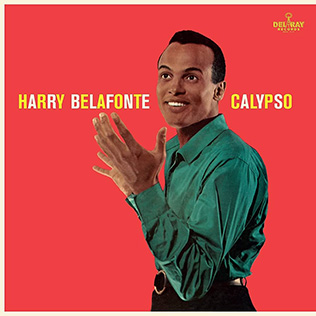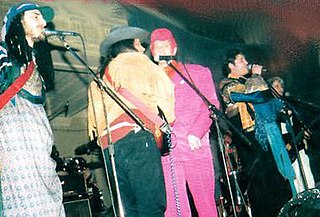Calypso is a style of Caribbean music that originated in Trinidad and Tobago during the early to mid-19th century and spread to the rest of the Caribbean Antilles by the mid-20th century. Its rhythms can be traced back to West African Kaiso and the arrival of French planters and their slaves from the French Antilles in the 18th century.

Harry Belafonte was an American singer, actor, and civil rights activist who popularized calypso music with international audiences in the 1950s and 1960s. Belafonte's career breakthrough album Calypso (1956) was the first million-selling LP by a single artist.

Stan Freberg was an American actor, author, comedian, musician, radio personality, puppeteer and advertising creative director.
Mento is a style of Jamaican folk music that predates and has greatly influenced ska and reggae music. It is a fusion of African rhythmic elements and European elements, which reached peak popularity in the 1940s and 1950s. Mento typically features acoustic instruments, such as acoustic guitar, banjo, hand drums, and the rhumba box — a large mbira in the shape of a box that can be sat on while played. The rhumba box carries the bass part of the music.

The Fontane Sisters were a trio from New Milford, New Jersey.
"Jamaica Farewell" is a Jamaican-style folk song (mento). The lyrics for the song were written by Lord Burgess, an American-born, half-Barbadian songwriter. It is about the beauties of the West Indian Islands.
"Marianne" is a traditional calypso song made popular by Trinidadian calypsonian Roaring Lion. Writing credits on the Easy Riders recording are Terry Gilkyson, Richard Dehr, and Frank Miller.

Calypso is the third studio album by recording artist Harry Belafonte, released by RCA Victor (LPM-1248) in 1956. The album became his second consecutive number-one album on the Billboard Top Pop Albums chart, where it peaked for 31 weeks. Calypso was the first Long Play record album to sell over one million copies.
The Tarriers were an American vocal group, specializing in folk music and folk-flavored popular music. Named after the folk song "Drill, Ye Tarriers, Drill", the group had two hit songs during 1956-57: "Cindy, Oh Cindy" and "The Banana Boat Song." The two singles became US Top Ten hits and peaked at No. 26 and No. 15 respectively in the UK Singles Chart.
"Rock Island Line" is an American folk song. Ostensibly about the Chicago, Rock Island and Pacific Railroad, it appeared as a folk song as early as 1929. The first recorded performance of "Rock Island Line" was by inmates of the Arkansas Cummins State Farm prison in 1934.
"Choucoune" is a 19th-century Haitian song composed by Michel Mauléart Monton with lyrics from a poem by Oswald Durand. It was rewritten with English lyrics in the 20th century as "Yellow Bird". Exotica musician Arthur Lyman made the song a hit in 1961.

Belafonte at Carnegie Hall is a live double album by Harry Belafonte issued by RCA Victor. It is the first of two Belafonte Carnegie Hall albums, and was recorded on April 19 and April 20, 1959. The concerts were benefits for The New Lincoln School and Wiltwyck School, respectively. The album stayed on the charts for over three years.
"Jumbie Jamberee" is a calypso song credited to Conrad Eugene Mauge, Jr. In 1953 Lord Intruder released the song as the B-side to "Disaster With Police". The song is also known as "Zombie Jamboree" and "Back to Back". The introduction to the Kingston Trio's version humorously credits "Lord Invader and his Twelve Penetrators" with authorship of the song instead of Lord Intruder.
Irving Louis Burgie, sometimes known professionally as Lord Burgess, was an American musician and songwriter, regarded as one of the greatest composers of Caribbean music. He composed 34 songs for Harry Belafonte, including eight of the 11 songs on the Belafonte album Calypso (1956), the first album of any kind to sell one million copies. Burgie also wrote the lyrics of the National Anthem of Barbados. To date, songs penned by Irving Burgie have sold more than 100 million copies worldwide.
A notable year in the history of Jamaican music was 1907, when Walter Jekyll's Jamaican Song and Story was first published. The contents of this book include four parts entitled "Anancy Stories", "Digging Sings", "Ring Tunes", and "Dancing Tunes". Each part has an introduction, songs, stories, and melodies.

The Kuguars were a successful short-lived Serbian comedy rock band from Belgrade, mainly consisting of famous Serbian actors. Formed in 1997, the band released two albums featuring humorous songs, before disbanding in 2001.
"Mama Look at Bubu" is a song written by Trinidadian calypsonian Lord Melody, Harry Belafonte and Lord Burgess, and performed by Harry Belafonte featuring Bob Corwin's Orchestra & Chorus featuring Millard Thomas, Franz Casseus and Victor Messer on guitars. Although Belafonte gets co-writing credit on his 1957 release, the song first appeared on Lord Melody's single "Mama Look a Boo Boo" in 1955, and his debut album "Calypso Fiesta – Limbo In Trinidad" in 1956, with solo writing credit to Lord Melody.

"Banana" is a song by the Jamaican reggae artist Conkarah featuring the Jamaican international artist Shaggy. The song released in 2019 by S-Curve Records samples largely and is an adaptation of a famous song by Harry Belafonte called "Day-O " released in 1956. The Belafonte original is a work song, from the point of view of dock workers working the night shift loading bananas onto ships. The lyrics describe how daylight has come, their shift is over, and they want their work to be counted up so that they can go home.

Pop 'n' Mento is the third album by Jamaican mento band the Jolly Boys, released in September 1989 by American label First Warning and British label Cooking Vinyl. The album was produced by American singer-songwriter Jules Shear, who discovered the Jolly Boys performing in a Port Antonio hotel. He digitally recorded the group in one take, using a minimal set-up to accommodate the group's acoustic instruementation. The record features a set of mento standards, and mixed elements from the genre's past with contemporary sounds.








